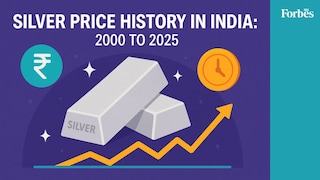Silver price history in India: 2000 to 2025
Want to buy silver? Here's everything you need to know about the silver prices over the decades, how to invest, and what the taxation rules are


Silver has always had a steady place in Indian households, second only to gold, but no less significant. Its importance goes beyond mainstream traditions. From family heirlooms and temple offerings to large-scale industrial use, silver continues to hold value across different sections of society and industry.
The metal plays a key role in sectors like electronics, photovoltaic cells, and medical equipment, all of which could influence the current silver price. A mix of global markets, industrial demand, and cultural buying trends shapes the price of silver in India.
In this article, we’ll discuss the past prices and current shifts, how to invest in silver in India, and the tax rules to consider before buying the metal.
Final silver price = (Silver price per gram X Purchase volume X Purity) + 3% GST + Making charges (if applicable)
Beyond this, the cost of silver is shaped by several domestic and global factors:
Global silver prices: Since India imports most of its silver, international rates are the starting point for domestic pricing. Any shift in global demand or supply can directly impact the current silver price.
INR-dollar exchange rate: A weaker rupee against the dollar makes silver imports costlier, pushing prices higher in India.
Industrial demand: Silver"s use in solar panels, electronics, the chemical industry, and medical devices means that rising demand from these sectors can influence the silver price.
Inflation and interest rates: When inflation rises, silver often attracts more buyers, which can increase prices. However, when interest rates are high, they reduce investors’ interest in silver, potentially leading to a decrease in prices.
Mining output and government policies: Disruptions in supply, higher extraction costs, and import duties all add to the final price of silver for Indian buyers.
| Year | Silver Price (in ₹/kg) |
|---|---|
| October 28, 2025 | 1,65,000 |
| October 13, 2025 | 195,000 |
| September 9, 2025 | 1,30,000 |
| 2024 | 95,700 |
| 2023 | 78,600 |
| 2022 | 55,100 |
| 2021 | 62,572 |
| 2020 | 63,435 |
| 2019 | 40,600 |
| 2018 | 41,400 |
| 2017 | 37,825 |
| 2016 | 36,990 |
| 2015 | 37,825 |
| 2014 | 43,070 |
| 2013 | 54,030 |
| 2012 | 56,290 |
| 2011 | 56,900 |
| 2010 | 27,255 |
| 2009 | 22,165 |
| 2008 | 23,625 |
| 2007 | 19,520 |
| 2006 | 17,405 |
| 2005 | 10,675 |
| 2004 | 11,770 |
| 2003 | 7,695 |
| 2002 | 7,875 |
| 2001 | 7,215 |
| 2000 | 7,900 |
Back in 2018-2019, the price of silver in India hovered around ₹40,000 per kg. After the COVID-19 pandemic, silver prices started spiking steadily, crossing ₹ 78,000 in 2023, driven by demand and supply, as well as rising interest from both investors and industries.
Silver coins: These are suitable for smaller investments. Readily available through banks and jewellers, though they may charge a slightly higher premium due to design and packaging.
Silver bars: These are preferred by those who want to invest larger sums. They’re available via reputed dealers or jewellers and offer better value per gram, but require secure storage.
Silver jewellery: Deco ornaments or jewellery aren’t ideal for pure investment purposes due to the presence of mixed metals and additional making charges.
Silver ETFs: They track the spot price of silver in real time. Fund managers hold physical silver, and the net asset value (NAV) moves in line with the market. SEBI regulations ensure clarity and transparency.
Commodity market (futures): This is a market-linked option where returns can fluctuate. It doesn’t involve holding physical silver and is generally used by those with a higher risk appetite.
As the price of silver in India changes with global and domestic trends, understanding each investment format helps you plan better.
For investments like silver ETFs, taxation is based on how long the asset is held:
First Published: Jul 31, 2025, 14:56
Subscribe Now